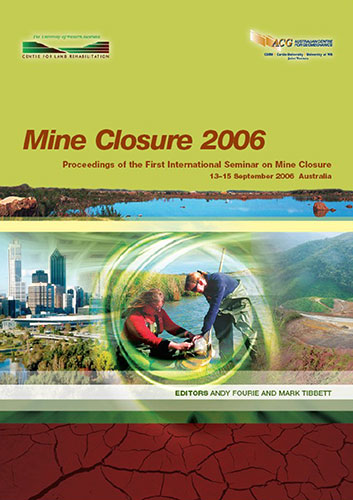Innovative Mine Closure Design Based on Observations of Mine and Natural Analogues

|
Authors: Williams, DJ; Kline, JT |
DOI https://doi.org/10.36487/ACG_repo/605_48
Cite As:
Williams, DJ & Kline, JT 2006, 'Innovative Mine Closure Design Based on Observations of Mine and Natural Analogues', in AB Fourie & M Tibbett (eds), Mine Closure 2006: Proceedings of the First International Seminar on Mine Closure, Australian Centre for Geomechanics, Perth, pp. 559-568, https://doi.org/10.36487/ACG_repo/605_48
Abstract:
Conventionally, mine closure design is based on the desirability of a vegetated surface, preferably one that supports some future productive land use, such as the grazing of domesticated animals. A vegetated mined landform is also seen to be more aesthetically pleasing than a bare landform. However, mined landforms necessarily involve relatively steep slopes and, in arid climates, the best vegetative cover possible would be sparse. To achieve even a sparse vegetative cover in an arid climate would require the placement of a fine- grained growth medium on the surface. However, a sparsely vegetated fine-grained surface cover on a relatively steep slope is prone to erosion (Williams, 2002). This is conventionally addressed by the construction of rock-lined contour and downslope drains to limit the velocity of runoff flow over the erosion- prone surface cover. However, drains concentrate flow, making them, the inlet and outlet structures, and their surrounds, susceptible to erosion (Williams et al., 2004). Observations of the outer slopes of San Manuel Mine’s tailings storages in Arizona’s arid climate showed them to be prone to piping erosion. Observations of covers of natural fine and coarse-grained alluvium placed on the tailings slopes showed that the alluvium suffered a washout of fines and sand during rainfall events, leading to the eventual loss of the cover and piping erosion of the exposed tailings. Observations of natural alluvial slopes showed that unless they are cemented or overlain by a dense, coarse-grained cap, they were also prone to erosion by storms. It became apparent that a rip rap cover, without constructed drains, would be required to reduce the risk of failure of the cover on the tailings outer slopes and exposure of the underlying tailings. The paper illustrates the observational approach employed in support of the recommended cover option for the tailings outer slopes.
References:
SRK Consulting (2004) Private communication.
Williams, D.J. (2002) Engineering closure of an open pit gold operation in a semi-arid climate. International Journal of
Surface Mining and Reclamation, Special Edition on Mining and the Environment, 16(4), pp. 270-288.
Williams, D.J., Loch, R.J. and Vacher, C. (2004) Risk assessment applied to tunnel erosion of mine spoils. Proceedings
11th International Conference on Tailings and Mine Waste ’04, Vail, Colorado, 10-13 October 2004, pp. 63-70.
Innovative Mine Closure Design Based on Observations of Mine
and Natural Analogues
D.J. Williams, J.T. Kline
568 Mine Closure 2006, Perth, Australia
© Copyright 2025, Australian Centre for Geomechanics (ACG), The University of Western Australia. All rights reserved.
View copyright/legal information
Please direct any queries or error reports to repository-acg@uwa.edu.au
View copyright/legal information
Please direct any queries or error reports to repository-acg@uwa.edu.au